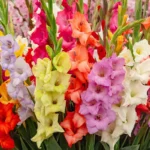
Cherry blossoms, also known as “sakura” in Japanese, have enchanted people for centuries with their delicate beauty and profound symbolism. These ephemeral flowers have left an indelible mark on cultures around the world, from their ancient origins in Japan to the annual springtime celebrations in Washington, D.C. In this exploration of cherry blossoms, we delve into the historical facts, cultural significance, and numerical trivia that make these blossoms a cherished and timeless symbol of renewal and the transient nature of life. Join us as we journey through the captivating world of cherry blossoms, where beauty and symbolism converge in nature’s most exquisite form.
Origin in Japan: Cherry blossoms, or “sakura” in Japanese, hold a deep-rooted history in Japan, dating back over a thousand years. They are not just flowers but symbols of Japanese culture and aesthetics. The tradition of appreciating cherry blossoms, known as hanami, has evolved into a national custom celebrated by people of all ages. This tradition reflects the profound connection between the Japanese people and the fleeting beauty of cherry blossoms.
Hanami: Hanami, meaning “flower viewing,” has a history that stretches back to the Nara period (710-794) in Japan when the practice began among the aristocracy. It eventually spread to encompass people from all walks of life. The essence of hanami is not merely gazing at blossoms but also sharing food, drinks, and camaraderie under the flowering trees. This tradition fosters a sense of community and appreciation for the ephemeral beauty of the cherry blossoms.
Cherry Blossom Festival: The National Cherry Blossom Festival in Washington, D.C., holds a special place in the hearts of Americans and symbolizes the enduring friendship between the United States and Japan. It was initiated when Japan gifted 3,000 cherry trees to the United States in 1912. The festival has grown in scale and significance, attracting tourists from around the world, and serves as a reminder of the strong cultural ties between the two nations.
Number of Cherry Trees: In Washington, D.C., there are more than 3,000 cherry trees, each contributing to the mesmerizing display of blossoms during springtime. These trees represent not only the physical presence of nature but also the collective effort and care that goes into maintaining them.
Yoshino Cherry: The Yoshino cherry tree variety, characterized by its delicate pale pink flowers, has become an emblematic representation of cherry blossoms in both Japan and the United States. Its widespread popularity is a testament to its enchanting beauty and grace.
Bloom Period: Cherry blossoms’ short-lived bloom, typically lasting just one to two weeks, reminds us of the fleeting nature of existence. It’s a poetic reminder that life, like the blossoms, is beautiful but impermanent.
Peak Bloom Date: The anticipation surrounding the peak bloom date in Washington, D.C., is a testament to the meticulous tracking and prediction of nature’s cycles. The precise prediction allows visitors to plan their trips to witness the blossoms at their most breathtaking moment.
Short-Lived Blossoms: Cherry blossoms’ ephemeral nature has deep cultural and philosophical significance in Japan, where they are often associated with the Buddhist concept of impermanence (mujō). This concept underscores the idea that all things in life are transitory, emphasizing the importance of cherishing the present moment.
Cherry Blossom Varieties: With over 200 cherry blossom varieties in Japan, each with its unique characteristics, these flowers offer a rich tapestry of beauty. The diversity of cherry blossoms showcases the intricate nuances of nature’s artistry.
Cherry Blossom Viewing Sites: Cherry blossom viewing sites in Japan, such as Maruyama Park in Kyoto and Ueno Park in Tokyo, not only provide a visual feast but also connect people with the historical and cultural significance of these places. These locations have witnessed generations of hanami gatherings, making them living testaments to the enduring tradition of cherry blossom appreciation.
Sakura and Samurai: The reverence for cherry blossoms among the samurai, Japan’s noble warrior class, reflects their appreciation for both the beauty and the transience of life. The samurai integrated cherry blossoms into their culture, often incorporating them into their armor and family crests. The cherry blossom’s symbolism as a fleeting yet beautiful flower resonated with the samurai’s code of living in the moment, being prepared for death, and embracing a life filled with honor.
Cherry Blossom Art: The Edo period (17th-19th century) in Japan witnessed a prolific outpouring of cherry blossom-themed art. Ukiyo-e woodblock prints, in particular, showcased the delicate allure of cherry blossoms. Artists like Hiroshige and Hokusai produced iconic works featuring cherry blossoms, and these artworks continue to be celebrated for their representation of seasonal beauty.
Cherry Blossom in Literature: Cherry blossoms have a rich literary presence in Japanese classics like “The Tale of Genji” by Murasaki Shikibu. In these works, cherry blossoms often serve as metaphors, representing themes of love, transience, and the passage of time. They add depth and layers of meaning to the stories.
Cherry Blossom Symbolism: Cherry blossoms are deeply symbolic in Japanese culture. They represent renewal, the arrival of spring, and the transient nature of life. The blossoms’ short-lived splendor mirrors the brevity of human existence, reminding people to appreciate the present moment.
Cherry Blossom Festivals Worldwide: Cherry blossom festivals have spread beyond Japan’s borders, showcasing the global appeal of these blossoms. South Korea’s Jinhae Cherry Blossom Festival, Taiwan’s Yangmingshan Flower Festival, and Germany’s cherry blossom festivals are just a few examples of how these flowers captivate people worldwide.
Cherry Blossom Records: The record-breaking height of a cherry blossom tree, over 177 feet (54 meters), exemplifies the awe-inspiring grandeur these trees can achieve. Such remarkable specimens become points of pride for communities and exemplify the potential for natural beauty in the world.
Cherry Blossom Viewing Record: The Guinness World Record for the largest gathering of people dressed as cherry blossoms, set in Japan with 2,036 participants in 2002, highlights the creativity and enthusiasm people have for celebrating these beloved flowers.
Cherry Blossom as a National Symbol: The cherry blossom being Japan’s national flower underscores its significance in Japanese culture and identity. It’s a symbol of pride, resilience, and an enduring connection to nature.
Cherry Blossom on Currency: The inclusion of cherry blossoms on the 100 yen coin showcases their importance in Japan’s daily life. As a commonly used denomination, the coin reminds people of the beauty that surrounds them.
Cherry Blossom Ice Cream: The creation of cherry blossom-flavored ice cream and other treats during sakura season is a delightful culinary tradition. These treats not only tantalize the taste buds but also immerse people in the seasonal celebration, creating a multisensory experience.
Cherry Blossom Symbolism in Washington: In Washington, D.C., cherry blossoms symbolize not only the beauty of nature but also the enduring friendship between Japan and the United States. The gift of cherry trees from Japan in 1912 was a gesture of goodwill, and their annual bloom continues to remind people of the strong cultural ties between the two nations. The blossoms serve as a living symbol of diplomacy and friendship.
Cherry Blossom Queen: The crowning of a Cherry Blossom Queen during the National Cherry Blossom Festival in Washington, D.C., is a tradition that highlights the cultural exchange between Japan and the United States. The Cherry Blossom Queen embodies grace, beauty, and the spirit of the festival, and her role reinforces the festival’s message of unity and cultural appreciation.
Cherry Blossom Artifacts: Cherry blossom-themed artifacts, including pottery, kimonos, and other traditional items, hold both historical and aesthetic value. These artifacts often feature intricate cherry blossom motifs, and their craftsmanship showcases the significance of the blossoms in Japanese culture. Collectors and enthusiasts worldwide appreciate these pieces for their beauty and cultural significance.
Cherry Blossom Season Photography: Cherry blossoms draw photographers from around the world who aim to capture the ephemeral beauty of the blossoms. The season provides a backdrop of vibrant pink and white flowers, creating stunning visuals that reflect the essence of spring. These photographs are not just artistic expressions but also a way to share the beauty of cherry blossoms with a global audience.
Cherry Blossom Festivals’ Economic Impact: The National Cherry Blossom Festival in Washington, D.C., has a significant economic impact on the city and the surrounding region. The influx of tourists and visitors stimulates local businesses, hotels, and the hospitality industry. Additionally, it fosters cultural exchange and education, making it not only a beautiful celebration but also an essential driver of economic and cultural growth.
Cherry Blossom FAQs: Unveiling the Delicate Dance of Spring
Cherry blossoms, with their ephemeral beauty and symbolic significance, have captivated cultures for centuries. Here are some FAQs to deepen your understanding of these enchanting flowers:
1. What are cherry blossoms?
Cherry blossoms are the delicate flowers of certain cherry tree varieties, particularly the Yoshino cherry (Prunus × yedoensis). These trees are not grown for fruit production; instead, they are prized for their spectacular springtime displays.
2. When do cherry blossoms bloom?
Cherry blossoms are known for their fleeting beauty. The exact blooming time depends on location and weather conditions, but typically occurs in late March to early April in temperate zones. Warmer temperatures trigger bud development, while sudden cold snaps can delay or damage the blossoms.
3. Where can I see cherry blossoms?
Cherry blossoms are native to East Asia, particularly China and Japan. However, they have been cultivated worldwide and can be found in many countries with temperate climates, including:
- Japan: Arguably the most famous destination for cherry blossom viewing (Hanami), with iconic locations like Ueno Park in Tokyo and Arashiyama Bamboo Grove in Kyoto.
- United States: Washington D.C.’s Tidal Basin is a popular spot, along with Brooklyn Botanic Garden in New York and Macon, Georgia, known as the “Cherry Blossom Capital of the World.”
- Canada: High Park in Toronto and Stanley Park in Vancouver offer stunning displays.
- Europe: Amsterdam’s Amstelpark and Kungsträdgården in Stockholm boast beautiful cherry blossoms.
4. How long do cherry blossoms last?
The cherry blossom bloom is a fleeting spectacle, typically lasting only 7-10 days. Once the flowers peak, the delicate petals begin to fall, creating a mesmerizing “snow” of pink and white blossoms.
5. What colors do cherry blossoms come in?
While the most iconic cherry blossoms are pale to deep pink, some varieties boast white or light green blossoms.
6. What is the significance of cherry blossoms?
Cherry blossoms hold deep cultural significance, particularly in Japan. They represent:
- Renewal and springtime: Their arrival signifies the end of winter and the beginning of a new season.
- Ephemeral beauty: Their fleeting nature serves as a reminder to appreciate the beauty and impermanence of life.
- Transience and change: The falling blossoms symbolize the impermanence of all things and the constant cycle of life and death.
7. Are cherry blossoms edible?
The blossoms of some cherry trees are edible and can be used in various recipes, such as teas, jams, and even pickled. However, it’s important to identify the specific tree variety before consuming the blossoms, as some are not edible.
8. What are some fun facts about cherry blossoms?
- The tradition of cherry blossom viewing (Hanami) in Japan dates back centuries, with people gathering under the blooming trees for picnics and celebrations.
- Cherry blossoms are not just for aesthetics; they are also a source of inspiration in art, literature, and music across various cultures.
- Weather forecasting plays a crucial role in cherry blossom viewing, with predictions of peak bloom times eagerly awaited.
9. How can I care for a cherry blossom tree if I plant one?
If you plant a cherry blossom tree, choose a variety suited to your climate and provide well-drained, slightly acidic soil. Full sun is ideal for optimal flowering. Prune minimally, focusing on shaping the young tree and removing dead or diseased branches.
10. Where can I learn more about cherry blossoms?
Many resources can deepen your knowledge of cherry blossoms:
- Tourist information websites for specific locations known for cherry blossom viewing.
- Botanical gardens or arboretums often showcase cherry blossom varieties.
- Online resources dedicated to cherry blossoms and their cultural significance.
Cherry blossoms, with their delicate beauty and symbolic meaning, offer a fleeting yet captivating reminder of nature’s wonders. Appreciating their ephemeral nature allows us to savor the present moment and celebrate the cycle of life.









